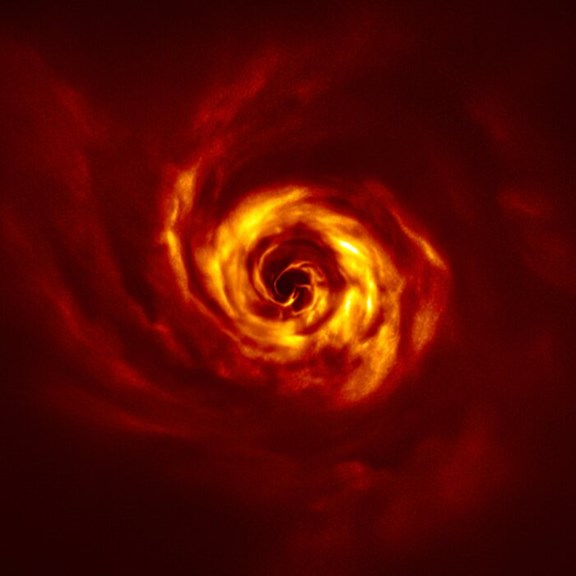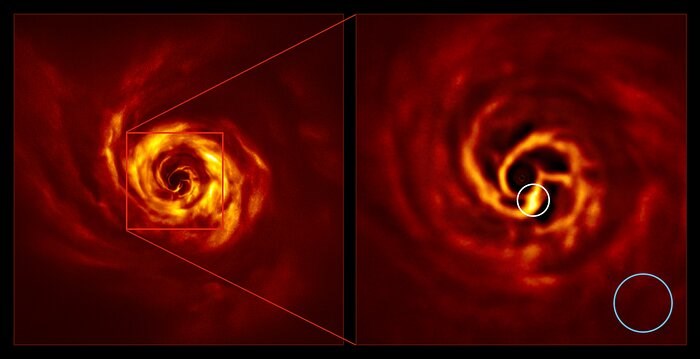Skynotes: June 2020
Latest space news
A milestone in human exploration of near-Earth space occurred on with the successful launch on May 30th (US time) of the SpaceX’s Crew Dragon spacecraft atop a Falcon 9 rocket taking two NASA astronauts to the International Space Station in the first crewed launch from the United States since the end of the Space Shuttle in 2011.
AB Aurigae - a planet in formation
Released recently is this best yet image of a newly forming planet. A proto-planet some 520 light years away is developing around the star Alpha Aurigae. More commonly knows as Capella, it is the sixth brightest star in the night sky, and lies in the constellation Aurigae (the charioteer). 'B' designates it as the first planet found in orbit, hence AB Aurigae. The star is surrounded by a broad circumstellar disc of gas and dust with spiral-like arms reminiscent of a miniature galaxy, and deep within one of those arms is a planet under construction.
To date there have been over 4000 planets identified by one means or another orbiting stars in our local region of the galaxy. This much anticipated close up look at a swirling disc of dust and gas reveals some of the process of beginning a planet. In one particular area material is accreting in a tight tendril with a twist. The pattern closely matches simulations made by astronomers of the density waves they believe would occur in a rotating proto-planetary disc. It has given astronomers the first direct evidence for the actual mechanism of such a dynamic process.
Researchers from France, Belgium, USA and Taiwan, led by Anthony Boccaletti of Paris Observatory made the announcement last week. The giant planet under formation is estimated to be 13 times the mass of Jupiter, and lies two and half times the distance from its parent star as Earth is from the sun (the equivalent of Neptune’s orbit, 30 AU).
In these side by side images, the red square in the left image is expanded on the right. Deep in this inner region of swirling tendrils a white circle marks a bright yellow twist believed to be the planet under formation. On the same scale the blue circle at lower right indicates the orbit of Neptune in our solar system.
Planetarium
While the Melbourne Planetarium and all Museums Victoria venues are closed, our websites are full of interesting content. Explore our astronomy factsheets and education pages as we continue to add exciting new material for our web visitors to learn from and enjoy.
Month highlights
Winter Solstice is on Sunday 21 June. On this day in the southern hemisphere the sun rises and sets at its most northerly points on the horizon, its path across the sky is lowest, and it is the shortest day of the year.
Penumbral Lunar Eclipse will occur on the night of Friday June 5 and into the next morning as about half the moon passes into the penumbra or outer shadow of the Earth. Unlike the more interesting partial or dramatic total eclipses, we will see only a slight dimming of our neighbour.
Melbourne sun times
| Date | Rise / Solar noon* / Set (day length) |
|---|---|
| Mon 1st | 7.26am / 12.18pm / 5.09pm (9.41 hrs) |
| Thu 11th | 7.32am / 12.19pm / 5.07pm (9.35 hrs) |
| Sun 21st | 7.35am / 12.21pm / 5.08pm (9.32 hrs) |
| Tue 30th | 7.36am / 12.23pm / 5.11pm (9.34 hrs) |
*When the Sun is at its highest crossing the meridian or local longitude.
Moon phases
| Phase | Date |
|---|---|
| Full Moon | Saturday 6th |
| Third Quarter | Saturday 13th |
| New Moon | Sunday 21st |
| First Quarter | Sunday 28th |
This month’s Moon perigee (closest to Earth) is on Wednesday 3rd at 364,366km and apogee (furthest from Earth) is on Monday 15th at 404,595km.
Planets
Mercury is a daytime object this month and not visible.
Venus can be seen this month rising an hour before sunrise from about 6am.
Earth has its June or mid-year solstices this month; winter solstice for southern hemisphere and summer solstice for northern hemisphere. Solstice comes from the Latin sol (sun) and sistere (stand still). The sun’s track across the sky from sunrise to sunset reaches a six-month extreme and goes no further. This marks winter solstice in the southern hemisphere. The sun will follow its most northerly and lowest daily path in the sky. Its rays will reach the ground at the shallowest angle (hence long shadows) and thereby give the least energy per square metre. It is the shortest day of the year. Conversely, it is the northern hemisphere’s summer solstice with opposite conditions, which for us in the south will be six months away.
Mars rises about 8pm and will move higher in the north until 7am when lost in pre-dawn light.
Jupiter is visible from 8pm and will rise in the east, move across the north and finally fade in the west in the early dawn light.
Saturn rises around 9pm following the same path as Jupiter until it too fades by 7am in the morning light.
Meteors
There are minor meteor showers this month centred in Scorpius and Sagittarius, and The Bootids can also appear from very late June into early July. Although low in number (less than 10 per hour) they can often be spectacular and bright with many displaying a yellow/orange colour. The best time to see meteors is after midnight with no moon in the night sky.
Stars and constellations
Low in the west we have our last look at Sirius, the brightest star in the night sky. Its constellation of Canis Major (the great dog) will soon disappear for the winter. In the Boorong tradition of north-east Victoria the brightest star is Warepil the wedge-tailed eagle, one of the most important law givers and guardians of the land.
Above and to the south of Sirius is the second brightest star in the night sky, Canopus in Carina (the keel). Looking further south and low to the horizon you may be able to identify the bright star Achernar in Eridanus (the river) at its lowest point in the sky. Directly above Achernar, the Southern Cross reaches its highest point and remains there majestically during the winter months.
Looking eastward, the bright red star Antares, in the constellation of Scorpius (the scorpion), can be seen. Below it lies the teapot shape of Sagittarius (the archer). The region around Sagittarius is a rich area of the sky to explore with binoculars. It points towards the centre of our Milky Way Galaxy, which lies 26,000 light years away and contains a supermassive black hole several million times the mass of the sun.
In the north is the star Regulus and the upside down constellation Leo (the lion) - his head and mane looking like an inverted question mark.
All these have indigenous alternatives from a long and rich tradition of aboriginal night sky observing.
To learn about our First People’s stories and knowledge go to the Australian Indigenous Astronomy website.
International Space Station
ISS orbits every 90 minutes at an average distance of 400 km appearing like a bright star moving slowly across the night sky. Here are some of the brightest passes expected this month over Melbourne and Central Victoria:
Wednesday 10th
Morning 6.24am-6.29am
West-South-West to North-East
Monday 22nd
Evening 6.18pm-6.23pm
North-West to South-East
For predictions go to the Heavens above website.
On this day
1st 2002, Czech Republic becomes the first country to ban light pollution.
2nd 1966, Surveyor 1 (USA) lands on Moon as first probe to land on another body.
3rd 1965, Ed White takes America’s first spacewalk as part of Gemini IV.
6th 1971, Soyuz 11 (USSR) carries the first people to a space station (Salyut 1).
7th 1879, Joan Voute proves with parallax that dwarf star Proxima Centauri is the same distance as Alpha Centauri binary.
8th 2004, a Transit of Venus is observed, the first in 122 years.
9th 1986, Rogers report on Space Shuttle Challenger explosion reveals solid rocket booster fault and serious management and safety problems with US program.
10th 2003, launch of Mars Exploration Rover Spirit (USA) which lands in 2004 and exceeds expectations operating to 2010.
13th 1983, Pioneer 10 (USA) becomes the first spacecraft to travel beyond the planets of the Solar System.
13th 2010, Hyabusa (Japan) craft returns the first asteroid samples to Earth.
14th 1962, European Space Research Organisation (ESRO) begins, later to be part of European Space Agency (ESA).
15th 763 BCE, Assyrians record a total solar eclipse which has helped in dating other events in Mesopotamian history.
16th 1911, a meteorite weighing 772g strikes a barn in rural Wisconsin (USA).
16th 1963, Valentina V. Tereshkova (USSR) is the first woman in space in Vostok 6, the first civilian into space, and the only woman to undertake a solo space flight.
17th 1969, Venera 6 (USSR) descends into Venus’ dense atmosphere sending data before being crushed by rising pressure.
18th 1983, Sally Ride is first American woman in space aboard Shuttle Challenger.
20th 1990, Asteroid Eureka found as part of the Trojans asteroid group orbiting at Mars’ L5 Lagrange point.
21st 2004, SpaceShipOne (USA) launched as first privately-funded human space flight.
21st 2006, Pluto’s small moons Nyx and Hydra are named.
22nd 1633, Galileo recants his sun-centred solar system model under threat of torture by the Catholic Inquisition.
22nd 1978, Dr James W. Christy (USA) discovers Pluto’s large moon Charon.
24th 1883, discoverer of cosmic rays, Victor Francis Hess, is born.
24th 1915, birth of Fred Hoyle, who explained the creation of elements in stars, promoted the steady state universe, and coined the pejorative term ‘big bang’ for the rival model of the universe’s creation.
29th 1818, Angelo Secchi born, one of the first astronomers to believe the Sun is a star.
29th 1995, Space Shuttle Atlantis (USA) – first docking at Russia’s Mir Space Station.
30th 1908, a meteor several metres in size explodes over Tunguska (Russia) destroying 2,200 km2 of forest in a multi-megaton blast.
30th 1971, Soyuz 11 (USSR) was the only mission to visit the first space station Salut 1 (USSR) after which its crew of three became the only humans known to have died in space when their cabin depressurised prior to re-entry.








